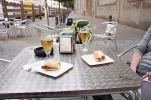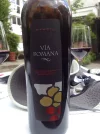On my last two Caminos, I typically drank one half to a full bottle of red wine a day. I had no ill effects. In fact, just the opposite: it enhanced an already incredible experience.
I have diligently tried to replicate this at home with unfortunate results: it disturbed my sleep and led to a general malaise (hangover} the next day. Being of a naturally inquiring and analytical bent of mind, I am determined to plumb the depths of this strange phenomenon:
Why I am able to imbibe with impunity verging on extreme pleasure on the Camino while at home, I might as well be drinking hemlock?
























